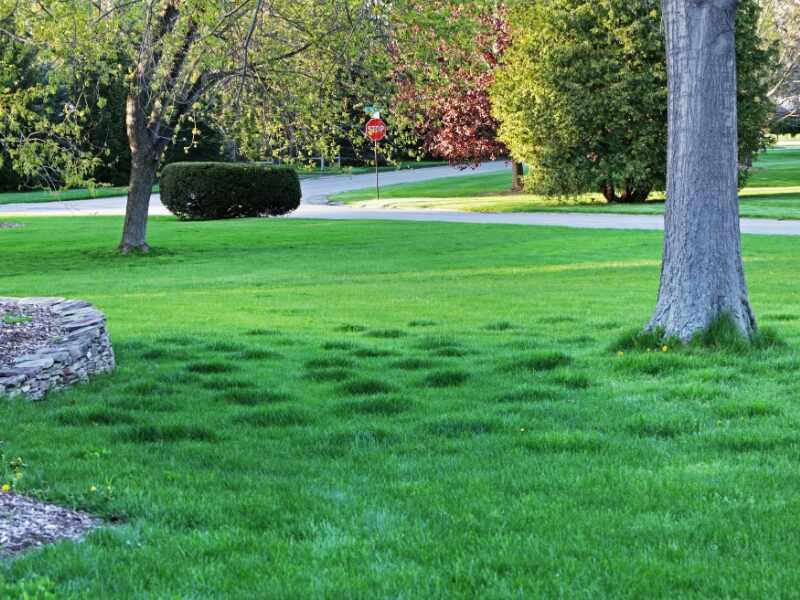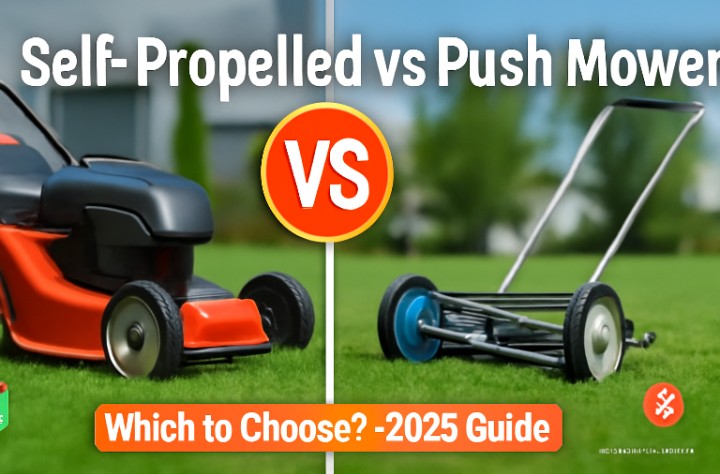My neighbor Jake called me over last weekend. His lawn looked terrible – brown spots everywhere. “What happened here?” I asked, looking at the mess. He just shrugged. “No idea. It was fine last month.” Sound familiar? Yeah, patchy lawns sneak up on you. One day everything looks good. Next thing you know, your yard’s a disaster.
I have dealt with this stuff for years. Watched friends spend hundreds trying random fixes. Most of them made things worse. But here’s what actually works. No fancy tricks or expensive products needed.
What Makes Lawns Look Like Garbage
Let’s be real about what ruins grass. Most people guess wrong about their lawn problems. Your grass doesn’t just randomly decide to die. Something’s killing it. Finding that something saves you time and money.
Patchy grass makes your house look neglected. Even if you spend hours on other yard work. It’s the first thing people notice. Property values drop too. Nobody wants to buy a house with a dead lawn.
The Real Troublemakers
Mother Nature Isn’t Always Nice
Trees cause more lawn problems than anything else. That big oak you love? It’s choking your grass. Most grass needs four hours of direct sun. Less than that? Forget about thick, green coverage.
My buddy Tom learned this the hard way. Planted expensive seed three times under his maple tree. Same result every time – thin, pathetic grass. Weather extremes kill grass fast. Last summer’s drought wiped out half the lawns in my neighborhood. Spring’s heavy rains washed away everyone’s new seed.
Your Soil Might Be Concrete
Hard soil stops grass seeds cold. They can not break through to grow. Success or failure of a home lawn is closely tied to how well the soil was prepared. I grabbed a screwdriver once to check my soil. Couldn’t push it in past two inches. No wonder my grass looked sick.
Poor soil prep ruins lawns before they start. Contractors cut corners all the time. They smooth over construction debris and call it good. Missing nutrients starve grass slowly. You might not notice for months. Then everything turns yellow and thin.
Daily Mistakes Add Up
Watering wrong ruins more lawns than drought. Too much here, not enough there. Grass can not handle the confusion.
Bad mowing kills grass fast. Dull blades tear instead of cut. Cutting too short stresses everything. I see scalped lawns everywhere in spring. Forgetting fertilizer starves grass. Even good soil runs out of food eventually. Hungry grass gets weak and patchy.
The Stuff That Attacks Your Grass
Dog pee burns perfect circles in lawns. Dog pee kills grass because of too much nitrogen. My German Shepherd created dozens of these spots last year. Concentrated urine from numerous animals including foxes, deer, geese, cats and dogs has the capacity to injure or severely damage turfgrasses.
Heavy traffic beats grass to death. Kids playing, parties, regular walking paths. Soil gets packed down. Roots can’t breathe or spread. Grubs eat grass roots underground. You won’t see them until damage shows up. Those dead patches that appeared overnight? Probably grubs.
Disease spreads fast in stressed grass. Excess nitrogen in the soil from pet waste can cause fungi to spread throughout your lawn. Birds ate my grass seed three springs running. Looked like tiny criminals having a feast. Had to cover everything with straw.
Figure Out What’s Wrong First
Don’t start throwing solutions at your lawn randomly. That wastes money and time. Round brown spots usually mean dog damage or disease. Irregular bare patches point to shade or traffic issues. Widespread thinning suggests soil problems.
When did you first notice problems? Recent damage needs different treatment than old issues.
Test your soil hardness with something sharp. Screwdriver, knife, whatever. Can not push it in easily? You’ve got compaction. Thin areas with existing grass? Try overseeding. Mostly bare dirt? You need complete reseeding.
Solution 1: Adding More Seed to Thin Spots
Overseeding means throwing grass seed on your existing lawn. Simple as that. Works great for thin areas. Costs way less than starting over. Takes patience though.
Don’t try this on bare dirt. Seeds need some existing grass for protection and structure.
When to Do It
Fall works best here in the West. Wait until night temperatures drop below 65°F. Your warm-season grass starts losing color. You need six to eight weeks before hard frost hits. Miss this window? Wait until next year.
How to Actually Do It
Cut existing grass down to one inch. Shorter is better. New seeds need contact with soil. Rake up every single grass clipping. Don’t leave any. They block seeds from soil contact.
Buy good seed that matches what you already have. Mixing types creates weird-looking patches. Spread seed with a broadcast spreader. Follow the bag directions. More isn’t better with grass seed.
Water immediately after seeding and continue daily until germination. Keep the soil consistently moist by lightly watering once or twice a day until the seedlings have reached the height of the rest of your lawn.
What to Expect
Eight weeks minimum for decent coverage. Don’t expect miracles in two weeks. Seeds germinate at different times. Your lawn will look patchy at first. That’s normal. Water daily until grass reaches two inches tall. Then switch to deeper, less frequent watering.
Solution 2: Starting Over Completely
Sometimes overseeding won’t cut it. Too much damage, too many weeds, soil problems. Time for complete reseeding. This means killing everything and starting fresh. Takes longer. Costs more. But gives better results for disaster lawns.
When You Need Nuclear Option
More than half weeds or bare soil? Overseeding won’t fix that mess. Recurring disease problems need fresh starts. You can not overseed into infected grass. Serious soil issues require complete renovation. Fix the foundation while you’re replanting.
Differences from Overseeding
Kill all existing grass first. Creates blank canvas for new growth. Takes longer but produces uniform results. Same grass type and color everywhere. Costs significantly more. More materials, more labor, more time.
Making Your Lawn Level
Bumpy lawns collect water in low spots. Create mowing nightmares. Make everything look unprofessional. Level ground drains better. Easier to maintain. Mower doesn’t scalp high spots or miss low areas. Most bumps and dips develop slowly. Rain and foot traffic compress soil unevenly over time.
What Creates Uneven Ground
Soil settles naturally under pressure. Heavy rains compact some areas more than others. Walking paths get compressed first. Then spread outward with more traffic.
Bad initial grading shows up years later. Contractors who rush create problems that persist.
Small Bumps and Holes
Mix 40% topsoil, 40% sand, 20% compost for leveling. This drains well but holds nutrients. Apply half-inch maximum over low spots. Never bury existing grass completely. Work mixture into grass with rake or broom. Water lightly to settle everything.
Bigger Problem Areas
Deep depressions need special treatment. Cut H-shaped patterns around the problem area.Peel back grass strips carefully. Don’t tear them. You will replace them after adding fill. Add enough material to bring level up. Replace grass strips over leveled area.
After Leveling Work
Water gently to settle new soil. Don’t wash away your work with heavy streams. Add more topsoil once first application settles. Light, repeated applications work better than thick layers. Don’t overwater during recovery. Too much water washes away leveling material.
Getting Soil Ready for Success
Soil prep determines whether your repair works long-term. Skip it and problems return quickly. Remove dead grass and debris first. Everything that looks brown or feels squishy. Break up hard, compacted soil. Seeds need loose ground to germinate properly. Add compost if you can get it. Provides nutrients and improves soil structure.
Before You Plant Anything
Rake smooth. Remove rocks, sticks, trash. Create clean seedbed for new grass. Test soil pH if grass struggled before. Most grass prefers slightly acidic to neutral soil. Apply starter fertilizer according to package directions. New grass needs extra nutrition.
Fixing Hard Soil
Rent a core aerator for large areas. Pulls plugs to improve air circulation. Poke holes with garden fork for small spots. Every few inches. Improves drainage. Add sand to areas where water pools. Improves drainage long-term.
Getting Rid of Dead Grass Layer
Thick thatch prevents water from reaching roots. Remove buildup before overseeding. Rent power dethatcher for big jobs. Hand rake works for small areas. Bag all debris. Don’t leave it sitting on lawn. Creates barriers for new growth.
Stopping Future Problems
Regular maintenance prevents most lawn disasters. Way cheaper than major repairs. Water deeply but less often. Promotes deep root growth and drought resistance. Feed grass appropriately. Too much fertilizer burns. Too little starves.
Simple Care That Works
Water early morning when evaporation rates are low. Gives grass time to dry before evening. Fertilize three to four times yearly based on grass type. Cool-season needs different timing than warm-season. Keep mower blades sharp. Cut at proper height. Dull blades tear grass and invite disease.
Mowing Without Damage
Change mowing patterns every time. Different patterns prevent soil compaction from wheels. Never cut more than one-third of grass height at once. Stresses grass and creates thin spots. Alternate between horizontal and vertical patterns. Prevents rut formation from heavy equipment.
Keeping Weeds Out
Apply pre-emergent herbicide in early spring. Stops annual weeds before they start. Maintain thick, healthy grass. Best weed prevention method available. Dense lawns crowd out problems. Spot-treat individual weeds instead of broadcast spraying. Protects beneficial insects and reduces chemicals.
How Long This Actually Takes
Lawn repairs take way longer than people expect. Set realistic timelines or you’ll get frustrated. Overseeding shows results in eight to ten weeks. Complete establishment takes full growing season. Complete reseeding needs entire year to reach maturity. Plan accordingly.
Real Timeline Expectations
First two weeks after seeding are critical. Daily watering and traffic protection essential. Growth starts patchy as some seeds germinate faster. Evens out over time. Full establishment happens gradually over months. Continuous improvement throughout first growing season.
What to Do If It’s Not Working
Areas still patchy after two months? Apply more seed. Some spots need extra attention. Repeated overseeding failures mean deeper problems. Consider complete renovation. Monitor throughout first year for recurring issues. Early intervention prevents major repairs.
DIY vs Hiring Someone
Most small to medium lawn repairs work fine as DIY projects. Right tools and techniques produce professional results. Large areas or complex problems often need professional expertise. Experience and equipment make big difference. Consider your time and physical ability. Some repairs require sustained effort over weeks.
When to Call Pros
Areas over 1,000 square feet often need professional help. Equipment and materials get expensive for homeowners. Persistent drainage or soil problems need professional assessment. Proper diagnosis saves money long-term. Problems that keep returning despite your efforts indicate deeper issues. Professional soil testing reveals hidden problems.
DIY Pros and Cons
Small to medium repairs make great weekend projects. Basic tools and materials readily available. Work at your own pace and budget. Spread costs over time. Learn valuable skills. But mistakes get expensive to fix later. Improper timing or technique may need professional correction.
Money Comparison
Compare total DIY costs including your time value against professional quotes. Sometimes difference is smaller than expected. Factor in tool purchases and material waste for DIY calculations. Pros often get better material prices. Consider learning value and satisfaction of DIY success. Many homeowners enjoy maintaining their own landscapes.
Bottom Line
Start with proper diagnosis of what’s actually wrong. Don’t guess and waste money on wrong solutions. Pick repair method based on damage severity. Overseeding for thin areas, complete reseeding for disasters. Level surfaces and proper soil prep create foundation for lasting results. Skip these steps and problems return. Lawn recovery takes patience and consistent care. Eight weeks minimum for visible improvement. Full establishment takes longer.
Fall timing works best here in the West. Take advantage of optimal growing conditions. Your patchy lawn can become neighborhood showpiece. Proper assessment, appropriate methods, consistent follow-through. That’s the recipe that actually works.






